Bestsellers
-
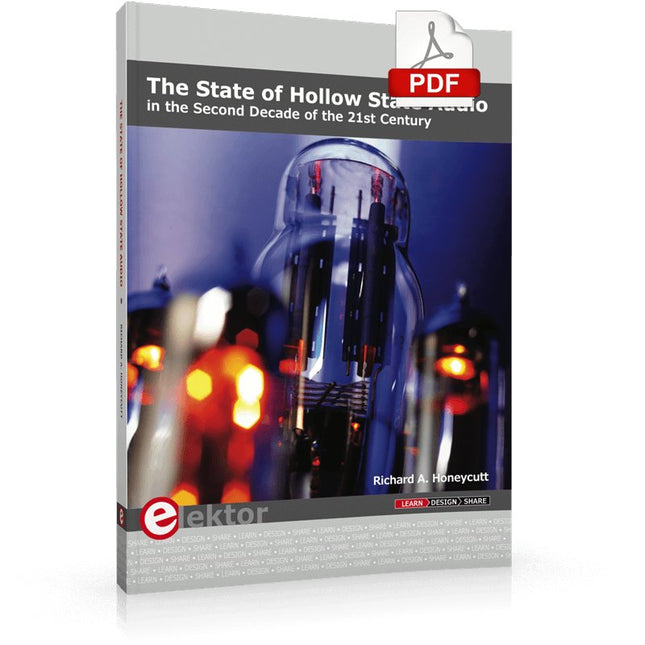
Elektor Digital The State of Hollow State Audio (E-book)
The State of Hollow State Audio in the Second Decade of the 21st Century Vacuum-tube (or valve, depending upon which side of the pond you live on) technology spawned the Age of Electronics early in the 20th Century. Until the advent of solid-state electronics near mid-century, hollow-state devices were the only choice. But following the invention of the transistor (after their process fell to reasonable levels), within a couple of decades, the death of vacuum tubes was widely heralded. Yet here we are some five decades later, and hollow-state equipment is enjoying something of a comeback, especially in the music and high-end audio industries. Many issues surround hollow-state audio: Does it produce—as some claim—better sound? If so, is there science to back up these claims? How do hollow-state circuits work? How do you design hollow-state audio circuits? If hollow-state equipment fails, how do you go about troubleshooting and repairing it? Can we recreate some of the classic hollow-state audio devices for modern listening rooms and recording studios? How can we intelligently modify hollow-state amplifiers to our taste? These and other topics are covered in The State of Hollow State Audio.
€ 32,95
Members € 26,36
-

Elektor Digital Elektor March/April 2024 (PDF)
Elektor GREEN and GOLD members can download their digital edition here. Not a member yet? Click here. CaptureCountAn Object Detector and Counter on the Raspberry Pi 5 Voltage Reference With Arduino Pro MiniLinearize and Calibrate Your Analog Inputs FPGAs for BeginnersThe Path From MCU to FPGA Programming Update: STM32 Wireless Innovation Design Contest 2024 Bluetooth LE With MAUIControl Apps for Android & Co. Port-Expanding Breakout BoardIncrease the Number of I/Os on Your Dev Board AI SpecialistMachine Learning with the Jetson Nano 2024: An AI OdysseyFirst Forays Into TensorFlow 262,144 Ways to Play The Game of LifeA Reader’s Project in Brief From Life’s ExperienceThe Chinese Dragon Get Your (Brushed DC) Motor Running!Sample Projects from the Elektor Motor Control Development Bundle ESP32-RS-232 AdapterA Wireless Link for Classic Test Equipment Starting Out in Electronics……More About Opamps ESP Library Recommendations Piezoelectric DevicesPeculiar Parts, the Series A Smart Object CounterImage Recognition Made Easy with Edge Impulse Resolve Your Trickiest Embedded Development Challenges ESP32 TerminalA Handheld Device with a Touch-Capable Display Getting Started With the Zephyr RTOSAs Powerful as It Is Hard to Master Award-Winning EthicsA Dialog with CTO Alexander Gerfer of Würth Elektronik eiSos on Enabling Innovation and Mindful Behavior Err-lectronicsCorrections, Updates, and Readers’ Letters Infographics: Embedded and AI Square Wave Generation BenchmarksExploring ESP32, Pico, and Other Microcontrollers
€ 7,50
Members € 6,75
-
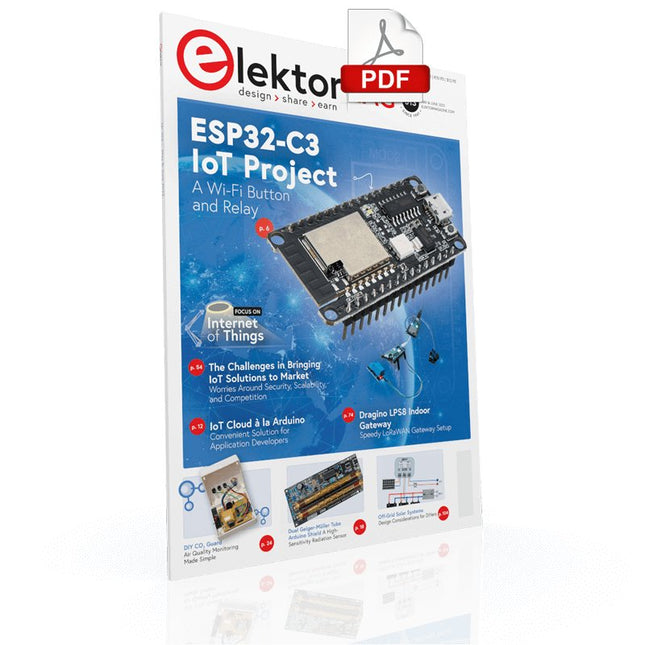
Elektor Digital Elektor May/June 2022 (PDF)
Your First Steps with an ESP32-C3 and the IoTA Wi-Fi Button and Relay IoT Cloud a la Arduino Dual Geiger-Müller Tube Arduino ShieldA High Sensitivity, Very Low-Power Radiation Sensor CO2 GuardA DIY Approach to Monitoring Air Quality MonkMakes Air Quality Kit for Raspberry PiMeasures Temperature and eCO2 Starting Out in ElectronicsWelcome to the Diode Tips & Tricks for Testing ComponentsNo Expensive Equipment Required Reducing the Power Consumption of Your Mole RepellerAn ATtiny13 Replaces a 555 Light Switch DeLuxA Solution for High-Precision Light-Controlled Switching The Challenges in Bringing IoT Solutions to MarketWorries Around Security, Scalability, and Competition Infographics 5-6/2022 Preferably Wired After AllTips for Developing a 1 Gbit/s Interface in an Industrial Environment Bringing Real-Time Object Detection to MCUs with Edge Impulse FOMO Traveling-Wave TubesPeculiar Parts, the Series Narrowband Internet of ThingsStandards, Coverage, Agreements, and Modules Dragino LPS8 Indoor GatewaySpeedy LoRaWAN Gateway Setup Explore ATtiny Microcontrollers Using C and Assembly LanguageSample Chapter: ATtiny I/O Ports Err-lectronicsCorrections, Updates and Readers’ Letters LoRa GPS Tracker UpdateReceive and Show Location Using a Raspberry Pi Circuit Simulation with TINA Design Suite & TINACloudSample Chapter: Sinusoidal Oscillators From Life’s ExperienceAssembly Line Work The WinUI Graphics Framework for Windows AppsA Small Demo Application GUIs with PythonWorst GUI of the world Off-Grid Solar SystemsElectrical Energy Independent of the Mains Grid The 10-Year SmartphoneRenew Your Expectations HexadokuThe Original Elektorized Sudoku
€ 7,50
Members € 6,75
-

Generic Heavy-Duty Aluminum Passive Cooling Case for Raspberry Pi 5
This rugged, passive aluminum cooling case is made specifically for the Raspberry Pi 5 and offers a sleek design that ensures both durability and effective heat dissipation. The case is exclusively compatible with the Raspberry Pi 5 and provides a passive cooling solution, eliminating the need for a fan while still managing heat efficiently. Features High quality aluminum construction: Made from high quality aluminum, this case is built to last and withstand regular use. Optimized heat dissipation: The passive cooling design uses the aluminum structure to keep your Raspberry Pi 5 cool without the need for a fan. Full port accessibility: Every port on the Raspberry Pi 5 is easily accessible, from the microSD card slot to USB, micro HDMI and GPIO ports. GPIO cable support: A reserved interface for the GPIO cable ensures that you can continue to use this important function without having to remove the case. Convenient power switch: The case has an integrated power switch that allows you to turn your device on and off.
€ 14,95
Members € 13,46
-
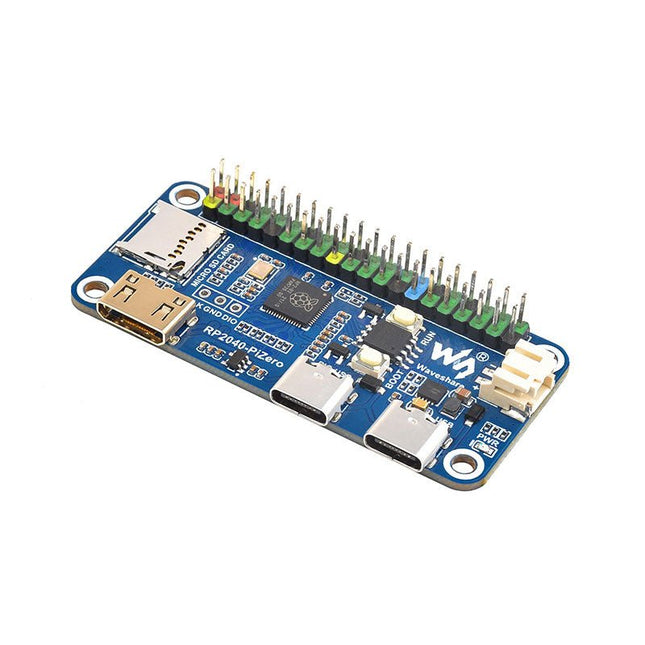
Waveshare Waveshare RP2040-PiZero Development Board
Waveshare RP2040-PiZero is a high-performance and cost-effective microcontroller board with onboard DVI interface, TF card slot and PIO-USB port, compatible with Raspberry Pi 40-pin GPIO header, easy to develop and integrate into the products. Features RP2040 microcontroller chip designed by Raspberry Pi Dual-core ARM Cortex M0+ processor, flexible clock running up to 133 MHz 264 KB of SRAM, and 16 MB of onboard Flash memory Onboard DVI interface can drive most HDMI screens (DVI compatibility required) Supports using as a USB host or slave via onboard PIO-USB port Onboard TF card slot for reading and writing TF card Onboard Lithium battery recharge/discharge header, suitable for mobile scenarios USB 1.1 with device and host support Drag-and-drop programming using mass storage over USB Low-power sleep and dormant modes 2x SPI, 2x I²C, 2x UART, 4x 12-bit ADC, 16x controllable PWM channels Accurate clock and timer on-chip Temperature sensor Accelerated floating-point libraries on-chip Downloads Wiki
€ 17,95
Members € 16,16
-
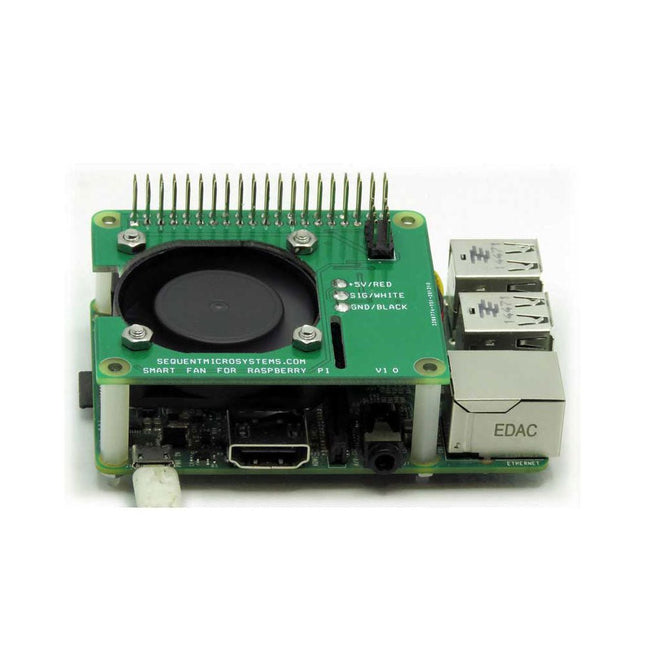
Sequent Microsystems Sequent Microsystems Smart Fan HAT for Raspberry Pi
Raspberry Pi cooling is a must. From the simplest passive heat sink, through elaborate fan blowers and even to an exotic water-cooled idea, many options are available. Sequent Microsystems Smart Fan has the form factor of the Raspberry Pi HAT. Its own tinny 32-bit processor receives commands from Raspberry Pi through the I²C interface. A step-up power supply converts the 5 V provided by Raspberry Pi to 12 V, ensuring precise speed control. Using pulse width modulation, it powers the fan just enough to maintain a constant temperature of the Raspberry Pi processor. The Smart Fan preserves all the GPIO pins, allowing any number of cards to be stacked on top of Raspberry Pi. If another add-on card has to dissipate power, a secondary Smart Fan can be added to the stack. DIN-Rail Mounting Together with multiple add-on cards, the Smart Fan can be installed on the DIN-Rail, for sturdy industrial applications. Stack Level Jumper Two Smart Fans can be installed on top of each Raspberry Pi. The assumption is that you have one more card in the stack which requires cooling. The bottom side of the Smart Fan has a jumper which needs to be installed on the second fan, in order for the Raspberry Pi to differentiate the two I²C addresses. Features 40 x 40 x 10 mm fan with 6 CFM airflow Step-up 12 V power supply for precise fan speed control PWM Controller modulates the fan to keep constant Pi temperature Draws less than 100 mA of power Stackable to itself, 2 fans can be added to Raspberry Pi Fully stackable allows adding other cards to Raspberry Pi Uses only I²C interface, leaves full use of all GPIO pins Super quiet and efficient Included Smart Fan HAT 40 x 40 x 10 mm Fan with mounting Screws Mounting Hardware Downloads User's Guide Open Source Hardware Schematic 2D CAD Drawing Command line Python Libraries Node-Red Nodes
€ 24,95
Members € 22,46
-
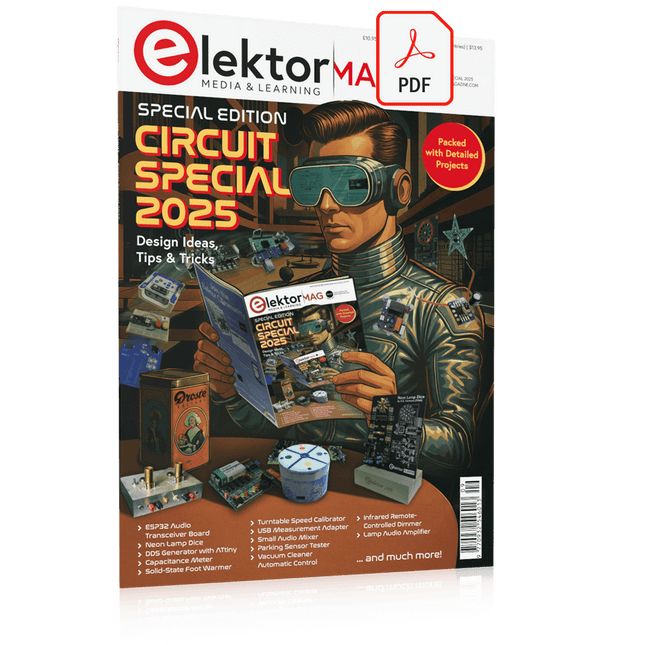
Elektor Digital Elektor Circuit Special 2025 (PDF) EN
Elektor GREEN and GOLD members can download their digital edition here. Not a member yet? Click here. USB Measurement AdapterTesting Current and Signal Quality of USB Ports 4...20 mA Current Output for Arduino UnoA Reliable, EMI-Insensitive Current Loop Interface Vacuum Cleaner Automatic ControlKeep Your Tools’ Work Area Clean DDS Generator with ATtiny Opamp-Tester V2New PCB – Now Also Suitable for SMDs 550-mW “Lamp” Audio AmplifierGet the Warm Sound of Vacuum Tubes With Ease Fuse GuardMonitoring a Fuse with a Flashing LED HQ RIAA PreamplifierGet the Most Out of Your Vinyl Records! Turntable Speed CalibratorAn Arduino-Based 100–120 Hz Strobe Light Generator Elektor Classics: video buffer/repeater Infrared Remote-Controlled DimmerControl Your Halogen or LED Floor Lamp Effortlessly and With Style How to Use switch…case on Strings in C++/Arduino IDE Magnet FinderWith a Simple Hall-Effect Sensor Raspberry Pi Smart Power ButtonA Solution for Raspberry Pi Up to Model 4 Essential Maker TipsProfessional Insights for Everyday Making Practical Projects with the 555 TimerDC Motor Control and Fast Reaction Challenges Basic AC-Load-On MonitorSave Energy with a Simple Device Power Banks in ParallelA Three-Day Continuous Power Solution VFO Up to 15 MHzAn Implementation With Raspberry Pi Pico Violin Tuner with ATtiny202 Elektor Classics: video amplifier for B/W television sets Capacitance Meter20 pF to 600 nF Quasi-Analog Clockwork Mk IITwo LED Rings for Hours and Minutes You Can Do Anything You Want(with the Arduino Ecosystem at Your Side) Neon Lamp Dice Elektor Classics: RTTY calibrator indicator Inspiring Hardware Designs for Your ESPs Elektor Classics: variable 3 A power supply RGB LEDs with Integrated Control CircuitLight with Precision: ICLEDs Set Standards Experiment: Towards a Mixed-Signal Theremin?Blending Modern Time-of-Flight Sensors With the Timeless XR2206 Analog Generator ESP32 Audio Transceiver Board (Part 1)SD Card WAV File Player Demo Infographics: Circuits and Circuit Design 2025 Small Audio MixerA Simple and Versatile Scalable Design Smart Staircase Light TimerSave More Money on the Energy Bill! Smarten Up Your ShuttersControlling Velux Hardware With an ESP32 and MQTT Solid-State Foot WarmerEnergy-Efficient Comfort Is the M5Stamp Fly Quadcopter the Next Tello? Boosting Wi-Fi Range of the ESP32-C3 SuperMiniA Simple and Effective Antenna Mod ZD-8968 Hot-Air Soldering StationA Budget-Friendly Workhorse or Just Hot Air? Parking Sensor TesterFinding Defects in the PDC System of a Car
€ 9,50
Members € 8,55
-
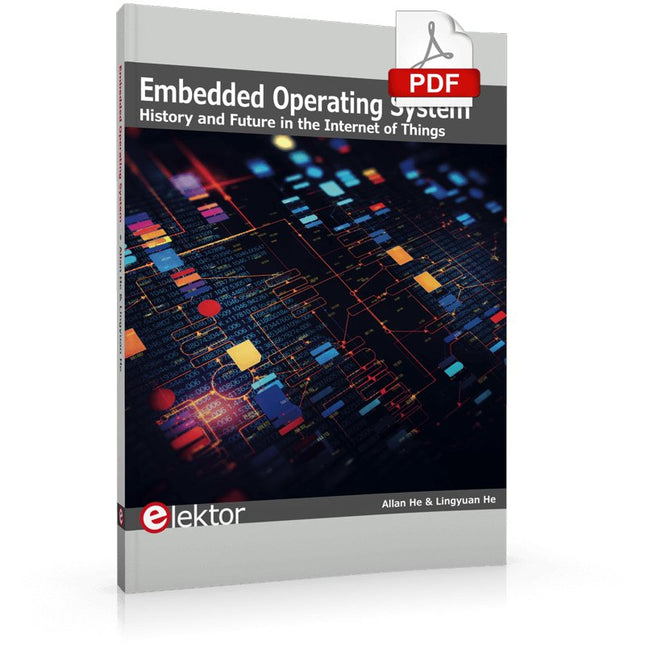
Elektor Digital Embedded Operating System (E-book)
History and Future in the Internet of Things This book thoroughly reviews the history of the development of embedded Operating Systems, covers the technical characteristics, historic facts, as well as background business stories of mainstream embedded Operating Systems, and analyzes the technical evolution, market development, and new opportunities of embedded Operating Systems in the age of the Internet of Things. From the perspective of time, the book examines the evolution of critical technical aspects, including real-time and Power Management of embedded Operating Systems and Linux, Internet of Things security, communication, and cloud computing. The book looks into applications of embedded Operating Systems with important markets of mobile phones, communication equipment, automobile, and wearable devices, and also discusses business model and the issue of intellectual property of embedded Operating Systems. In addition, the book walks through the status quo, technical features, product evaluation and background of the Internet of Things Operating Systems in the second half of the book.
€ 29,95
Members € 23,96
-

Elektor Digital The BeagleY-AI Handbook (E-book)
A Practical Guide to AI, Python, and Hardware Projects Welcome to your BeagleY-AI journey! This compact, powerful, and affordable single-board computer is perfect for developers and hobbyists. With its dedicated 4 TOPS AI co-processor and a 1.4 GHz Quad-core Cortex-A53 CPU, the BeagleY-AI is equipped to handle both AI applications and real-time I/O tasks. Powered by the Texas Instruments AM67A processor, it offers DSPs, a 3D graphics unit, and video accelerators. Inside this handbook, you‘ll find over 50 hands-on projects that cover a wide range of topics—from basic circuits with LEDs and sensors to an AI-driven project. Each project is written in Python 3 and includes detailed explanations and full program listings to guide you. Whether you‘re a beginner or more advanced, you can follow these projects as they are or modify them to fit your own creative ideas. Here’s a glimpse of some exciting projects included in this handbook: Morse Code Exerciser with LED or BuzzerType a message and watch it come to life as an LED or buzzer translates your text into Morse code. Ultrasonic Distance MeasurementUse an ultrasonic sensor to measure distances and display the result in real time. Environmental Data Display & VisualizationCollect temperature, pressure, and humidity readings from the BME280 sensor, and display or plot them on a graphical interface. SPI – Voltmeter with ADCLearn how to measure voltage using an external ADC and display the results on your BeagleY-AI. GPS Coordinates DisplayTrack your location with a GPS module and view geographic coordinates on your screen. BeagleY-AI and Raspberry Pi 4 CommunicationDiscover how to make your BeagleY-AI and Raspberry Pi communicate over a serial link and exchange data. AI-Driven Object Detection with TensorFlow LiteSet up and run an object detection model using TensorFlow Lite on the BeagleY-AI platform, with complete hardware and software details provided.
€ 34,95
Members € 27,96
-
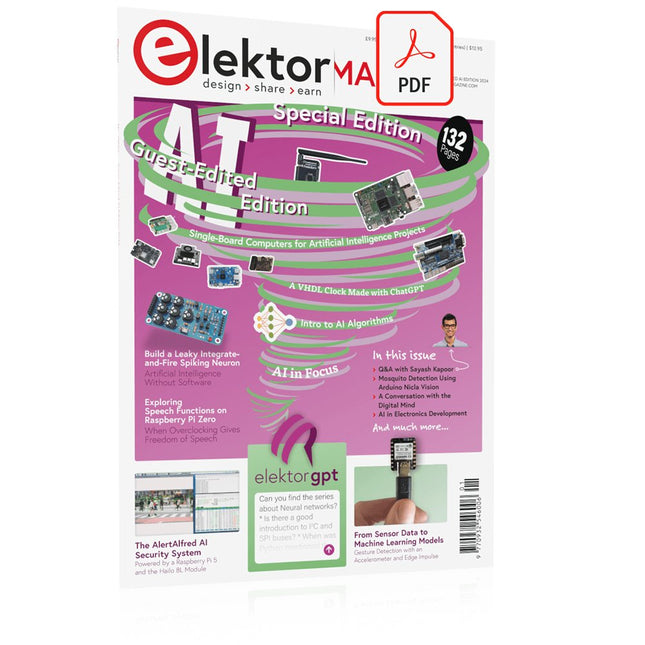
Elektor Digital Elektor AI Guest Edition 2024 (PDF) EN
Elektor GREEN and GOLD members can download their digital edition here. Not a member yet? Click here. The AlertAlfred AI Security SystemPowered by a Raspberry Pi 5 and the Hailo 8L Module AI in Electronics DevelopmentAn Update After Only One Year Intro to AI AlgorithmsPrompt: Which Algorithms Implement Each AI Tool? Single-Board Computers for Artificial Intelligence ProjectsBackground and Overview From Sensor Data to Machine Learning ModelsGesture Detection with an Accelerometer and Edge Impulse Build a Leaky Integrate-and-Fire Spiking NeuronArtificial Intelligence Without Software ChatGPT for Electronic DesignDoes GPT-4o Do It Any Better? Bringing AI to the Edge with ESP32-P4 Exploring Speech Functions on Raspberry Pi ZeroWhen Overclocking Gives Freedom of Speech The Growing Role of Edge AIA Trend Shaping the Future Unlocking the Power of Edge AIA Conversation with François de Rochebouët of STMicroelectronics A VHDL Clock Made with ChatGPT AI’s Real ImpactSayash Kapoor on “AI Snake Oil” and More The Latest Stuff From BeagleBoardBeagleY-AI, BeagleV-Fire, BeagleMod, BeaglePlay and BeagleConnect Freedom Mosquito Detection Using Open Datasets and Arduino Nicla Vision AI Today and Tomorrow: Insights from Espressif, Arduino, and SparkFun Artificial Intelligence Timeline BeagleY-AIThe Latest SBC for AI Applications AI in FocusPerspectives from the Elektor Community Machine Vision with OpenMVCreate a Soda Can Detector A Conversation with the Digital MindChatGPT vs Gemini Skilling Me Softly with This Bot?Is the AI Revolution in the Electronic Field Failing Due to a Lack of Social Precision?
€ 7,50
Members € 6,75
-
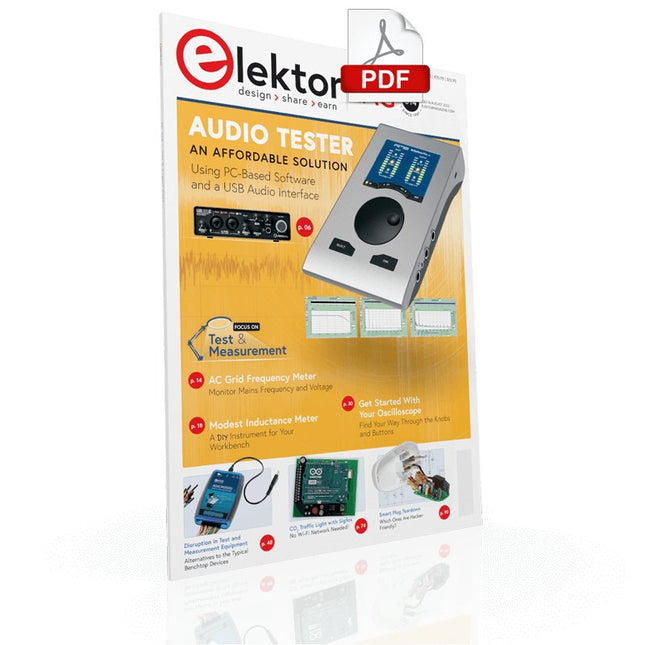
Elektor Digital Elektor July/August 2022 (PDF)
Measuring Does Not Have to be Expensive Low-Cost Audio TesterUsing PC-Based Software and a USB Audio Interface AC Grid Frequency MeterMonitor Mains Frequency and Voltage A Modest Inductance MeterAn Affordable Solution for Your Workbench Acoustic Wave HoveringA Look at the Makerfabs Acoustic Levitation Kit Starting Out in ElectronicsRectifiers E-FFWD: Looking Ahead Again! Get Started With Your OscilloscopeFind Your Way Through the Knobs and Buttons Raspberry Pi Pico Makes an MSF-SDRDecode a Time Signal with a Pi Pico SDR Moisture Sensors for Watering SystemsAutomatic Watering Disruption in Test and Measurement EquipmentInnovation from the Smaller Players Infographics 7-8/2022 Inspiration, That’s What It’s All AboutInterview with Entrepreneur Walter Arkesteijn, InnoFaith Beauty Sciences Minimizing EMC Interference from Storage Chokes GUIs with Python (Part 5)Tic-Tac-Toe Reed RelaysPeculiar Parts, the series Simple Analog ESR Meter With Moving-Coil Meter Precision Sigfox CO2 Traffic LightNo Wi-Fi Network Needed! Women in Tech“It's All About Merit Until Merit Has Tits” Low-Budget Tablet Oscilloscope ADS1013DGood Value for Money? Smart Plug TeardownWhich Ones Are Hacker-Friendly? Skin Impedance and Skin CapacitanceSmall Experiments From Life’s ExperienceNo Local Business Pokit Meter ReviewA Swiss army knife of test gear HexadokuThe Original Elektorized Sudoku
€ 7,50
Members € 6,75
-

Seeed Studio Seeed Studio Grove DHT11 Temperature & Humidity Sensor
The Grove DHT11 Temperature & Humidity Sensor is a high-quality, low-cost digital temperature, and humidity sensor based on the DHT11 module. It is the most common temperature and humidity module for Arduino and Raspberry Pi. It is widely favored by hardware enthusiasts for its many advantages such as low power consumption and excellent long-term stability. Relatively high measurement accuracy can be obtained at a very low cost. The single-bus digital signal is output through the built-in ADC, which saves the I/O resources of the control board. Features Dimensions: 40 x 20 x 8 mm Weight: 10 g Battery: Exclude Input Voltage: 3.3 V & 5 V Measuring Current: 1.3 mA- 2.1 mA Measuring Humidity Range: 5% - 95% RH Measuring Temperature Range: -20 ℃ - 60 ℃
€ 9,95
Members € 8,96
-
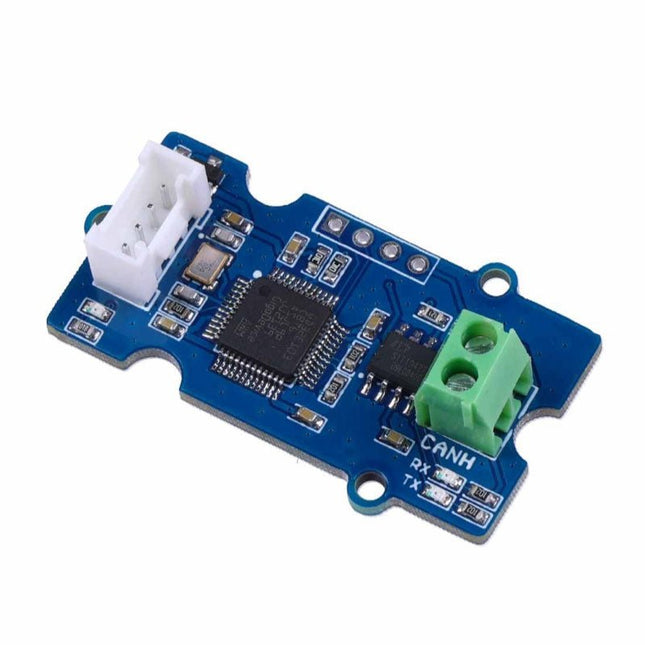
Seeed Studio Seeed Studio Grove CAN-BUS Module (based on GD32E103)
This Grove CAN-BUS Module based on GD32E103 adopts a brand-new design, uses the cost-effective and high-performance GD32E103 microcontroller as the main control and cooperates with a firmware we wrote to complete the function of the serial port to CAN FD. Features Support CAN communication: Implements CAN FD at up to 5 Mb/s Easy to program: Support AT command which enables simple serial port programming Grove ecosystem: 20 x 40 x 10 mm small size, 4-pin Grove connector to plug and play, Arduino compatible This Grove CAN-BUS Module supports CAN FD(CAN with Flexible Data-Rate) communication, which is an extension to the original CAN protocol as specified in ISO 11898-1 that responds to increased bandwidth requirements in automotive networks. In CAN FD, the data rate (i.e. number of bits transmitted per second) is increased to be 5 times faster than the classic CAN (5 Mbit/s for the data payload only, the arbitration bit rate is still limited to 1Mbit/s for compatibility). It supports AT command which enables simple serial port programming. This Grove CAN-BUS Module is based on GD32E103 with a frequency up to 120 MHz. It has a flash size from 64 KB to 128 KB and an SRAM size from 20 KB to 32 KB. Applications Car hacking: allows different parts of the vehicle to talk to each other, including the engine, the transmission, and the brakes. Windows, doors, and mirror adjustment. 3D Printers Building automation Lighting control systems Medical instruments and equipment Specifications MCU GD32E103 UART baud rate Up to 115200 (default 9600) CAN FD baud rate Up to 5 Mb/s Indicator TX and RX led Working voltage 3.3 V Grove connector 4-pin Grove connector to plug and play Size 20 x 40 x 10 mm Downloads Datasheet GitHub
€ 13,95
Members € 12,56
-
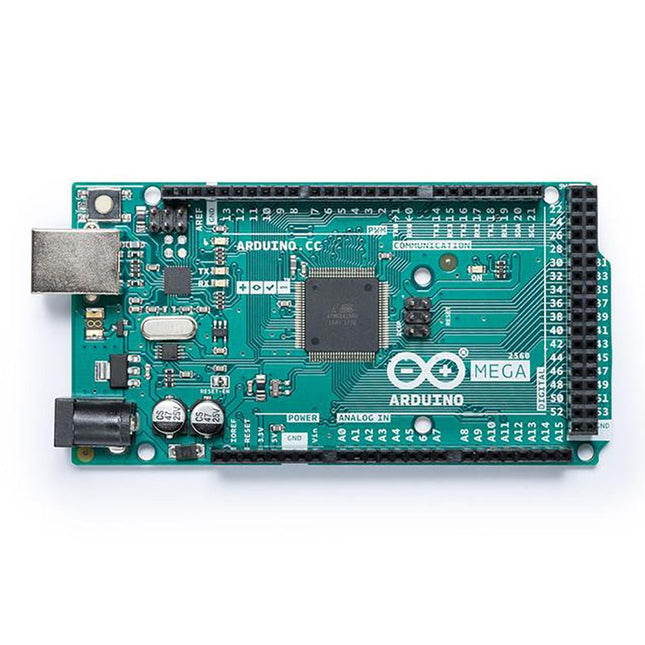
Arduino Arduino Mega 2560 Rev3
It contains everything needed to support the microcontroller; simply connect it to a computer with a USB cable or power it with an AC-to-DC adapter or battery to get started. The Mega 2560 board is compatible with most shields designed for the Uno and the former boards Duemilanove or Diecimila. Operating Voltage 5 V Input Voltage 7 V - 12 V Digital I/O 54 Analog Input Pins 16 DC Current per I/O Pin 20 mA DC Current for 3.3 V Pin 50 mA Flash Memory 256 KB of which 8 KB used by the bootloader SRAM 8 KB EEPROM 4 KB Clock Speed 16MHz LED_Builtin 13 Length 101.52 mm Width 53.3 mm Weight 37 g For more information, check out the Getting Started Guide from Arduino.
€ 44,95
Members € 40,46
-
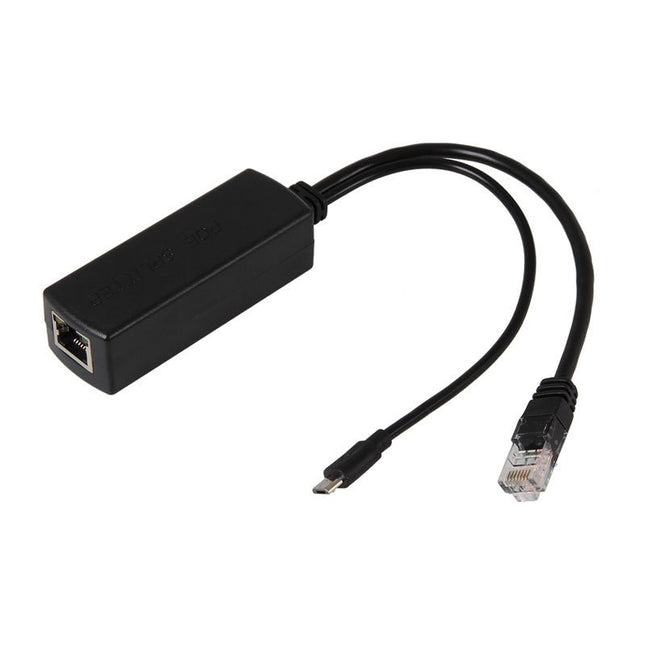
JOY-iT PoE Splitter (5 V) - Power over Ethernet for Single Board Computers
Features Jack: 1x Micro USB power plug + 1x RJ45 output port Input Voltage: 36~57 V (standard PoE voltage 48 V, 52 V) Output Voltage: DC 5 V Output Current: 2 A Transmission Distance: 10~100 m PoE Protocol: IEEE802.3af Network Bandwidth: 10/100 Mbps Weight: 40 g Product Dimension: 82 x 28 x 23 mm Cable Length: 205 mm Operation Temperature: -50 °C up to +75 °C
€ 16,95
Members € 15,26
-

Elektor Digital Designing Tube Amplifiers (E-book)
This book focuses more on practical aspects than on theory, and it has an contemplative nature, as though the author were viewing amplifiers from above. Knowledge elements are integrated and placed in the context of a broad overview. Even now tube amplifiers still sound great perhaps better than ever before. In part that is because we now have access to modern components such as toroidal output transformers, extremely high-quality resistors and capacitors, and many sorts of wire with good acoustic properties. Modern audio sources, such as CD players, and the latest top-end loudspeakers also enable us to appreciate how well tube amplifiers reproduce music even better than before. This new book from Menno van der Veen looks at tube amplifiers from more than just a theoretical perspective. It focuses primarily on the design phase, where decisions must be taken with regard to the purpose and requirements of the amplifier, and it addresses the following questions: How do these aspects relate to subjective and objective criteria? Which circuits sound the best, and why? If you want to develop and market an amplifier, what problems should you expect? What are the significance and meaning of measurements? Are they still meaningful, or have they lost their relevance? Thanks to the enormous processing power of computers, we can now measure more details than ever before. How can these new methods be applied to tube amplifiers? Previously it was sufficient to measure the frequency range, power and distortion of an amplifier in order to characterize the amplifier. Are these measurements still sufficient, or should we start measuring according to how we hear, using real music signals instead of waveforms from signal generators? The author sketches a future where amplifier measurements that conform to our sense of hearing enable us to arrive at new insights. This book focuses more on practical aspects than on theory, and it has an contemplative nature, as though the author were viewing amplifiers from above. Knowledge elements are integrated and placed in the context of a broad overview.
€ 29,95
Members € 23,96
-

Seeed Studio Seeed Studio Grove Beginner Kit for Arduino
Unlike most kits, the Grove Beginner Kit for Arduino is an all-in-one kit, no breadboard, no soldering, even no wiring is needed. The kit is powered by one Arduino compatible Board (Seeeduino Lotus) together with 10 additional Grove Arduino sensors all in one piece of the board. All the modules have been connected to the Seeeduino(Microcontroller) through the PCB stamp holes so no Grove cables are needed to connect. This is perfect for educational fields where frustrating wiring and soldering are no longer needed. Of course, you can also take the modules out and use Grove cables to connect the modules. You can build any Arduino project you like with this Grove Beginner Kit For Arduino. Included 1x Grove Beginner Kit For Arduino Board 1x Micro USB Cable 6x Grove Cables Included onboard 1x Grove LED 1x Grove Buzzer 1x Grove OLED Display 0.96" 1x Grove Button 1x Grove Rotary Potentiometer 1x Grove Light 1x Grove Sound 1x Grove Temperature & Humidity Sensor 1x Grove Air Pressure Sensor 1x Grove 3-Axis Accelerator 1x Seeeduino Lotus
€ 34,95
Members € 31,46
-

SparkFun SparkFun MicroMod nrf Processor
This module includes an integrated trace antenna, fits the IC to an FCC-approved footprint, and includes decoupling and timing mechanisms that would need to be designed into a circuit using the bare nRF52840 IC. The Bluetooth transceiver included on the nRF52840 boasts a BT 5.1 stack. It supports Bluetooth 5, Bluetooth mesh, IEEE 802.15.4 (Zigbee & Thread) and 2.4Ghz RF wireless protocols (including Nordic's proprietary RF protocol) allowing you to pick which option works best for your application. Features ARM Cortex-M4 CPU with a floating-point unit (FPU) 1MB internal Flash -- For all of your program, SoftDevice, and file-storage needs! 256kB internal RAM -- For your stack and heap storage. Integrated 2.4GHz radio with support for: Bluetooth Low Energy (BLE) -- With peripheral and/or central BLE device support Bluetooth 5 -- Mesh Bluetooth! ANT -- If you want to turn the device into a heart-rate or exercise monitor. Nordic's proprietary RF protocol -- If you want to communicate, securely, with other Nordic devices. Every I/O peripheral you could need. USB -- Turn your nRF52840 into a USB mass-storage device, use a CDC (USB serial) interface, and more. UART -- Serial interfaces with support for hardware flow-control if desired. I²C -- Everyone's favourite 2-wire bi-directional bus interface SPI -- If you prefer the 3+-wire serial interface Analogue-to-digital converters (ADC) -- Eight pins on the nRF52840 Mini Breakout support analogue inputs PWM -- Timer support on any pin means PWM support for driving LEDs or servo motors. Real-time clock (RTC) -- Keep close track of seconds and milliseconds, also supports timed deep-sleep features. Three UARTs Primary tied to USB interface. Two hardware UARTs. Two I²C Buses Two SPI Buses Secondary SPI Bus primarily used for Flash IC. PDM Audio Processing Two Analog Inputs Two Dedicated Digital I/O Pins Two Dedicated PWM Pins Eleven General Purpose I/O Pins
€ 29,95€ 22,95
Members identical
-

SparkFun SparkFun MicroMod Machine Learning Carrier Board
Voice recognition, always-on voice commands, gesture, or image recognition are possible with TensorFlow applications. The cloud is impressively robust, but all-the-time connection requires power and connectivity that may not be available. Edge computing handles discrete tasks such as determining if someone said 'yes' and responds accordingly. The audio analysis is done on the MicroMod combination rather than on the web. This dramatically reduces costs and complexity while limiting potential data privacy leaks. This board features two MEMS microphones (one with a PDM interface, one with an I²S interface), an ST LIS2DH12 3-axis accelerometer, a connector to interface to a camera (sold separately), and a Qwiic connector. A modern USB-C connector makes programming easy and we've exposed the JTAG connector for more advanced users who prefer to use the power and speed of professional tools. We've even added a convenient jumper to measure current consumption for low power testing. Features M.2 MicroMod Keyed-E H4.2mm 65 pins SMD Connector 0.5mm Digital I²C MEMS Microphone PDM Invensense ICS-43434 (COMP) Digital PDM MEMS Microphone PDM Knowles SPH0641LM4H-1 (IC) ML414H-IV01E Lithium Battery for RTC ST LIS2DH12TR Accelerometer (3-axis, ultra-low-power) 24 Pin 0.5mm FPC Connector (Himax camera connector) USB-C Qwiic connector MicroSD socket Phillips #0 M2.5x3mm screw included
€ 24,95€ 17,95
Members identical
-
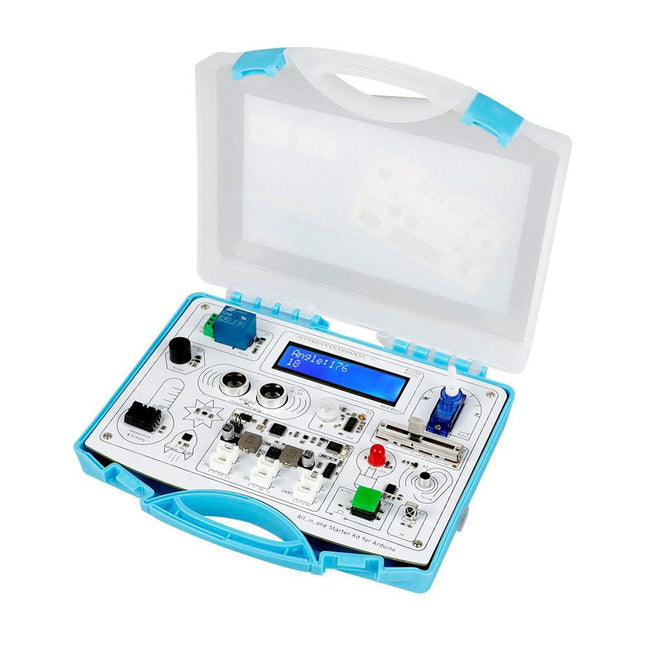
Elecrow Elecrow All-in-One Starter Kit for Arduino
15 Sensor Modules & 21 Tutorials The Elecrow All-in-One Starter Kit for Arduino is the perfect choice for beginners looking to explore the world of Arduino in a fun and accessible way. The kit includes more than 20 interactive tutorials, ranging from easy to advanced. These step-by-step guides help you master sensor usage, develop logical thinking skills, and spark your creativity. The kit contains 15 sensors in total: 14 built-in sensors and 1 humidity sensor with a Crowtail interface. Each sensor offers unique features and functions, making them ideal for Arduino novices. Additionally, the kit includes 6 Crowtail interfaces, enabling compatibility with over 150 types of Crowtail sensors and offering excellent expandability. These features make it a great entry-level tool for fostering logical thinking and innovation. Unlike most starter kits, this all-in-one kit uses a unified board design — no breadboard, no soldering, and no wiring required. This allows you to focus entirely on programming and learning Arduino. Features 15 sensors with different functions, 21 creative tutorials Common board design for sensors, no need to solder wires, direct use Portable suitcase (small and exquisite) Reserved 6 Crowtail interfaces (3x I/O, 2x I²C, 1x UART) Visualized silk screen printing, corresponding to the characteristics of each sensor Specifications All-in-one Starter Kit for Raspberry Pi Pico 2 All-in-one Starter Kit for Arduino Main Processor Raspberry Pi Pico 2 RP2350 ATmega328P Number of Sensors 17 sensors 15 sensors (including 1 Humidity sensor) Sensor Board Design Integrated sensor board, no soldering or complex wiring required Display 2.4-inch TFT full-color touch screen N/A Ambient Lights 20 full-color ambient lights, switchable via touch screen N/A Built-in Mini Games Yes No Expansion Interfaces N/A 6 Crowtail interfaces(3x I/O, 2x I²C, 1x UART) Programming Environment Based on Arduino software Number of Tutorials 21 creative tutorials Interface USB-C Dimensions 195 x 170 x 46 mm Weight 380 g 340 g Included 1x Elecrow All-in-One Starter Kit for Arduino 1x Moisture Sensor with Cable 1x IR Remote Control 1x USB-C Cable Downloads Datasheet Manual Wiki
€ 44,95€ 34,95
Members identical
-
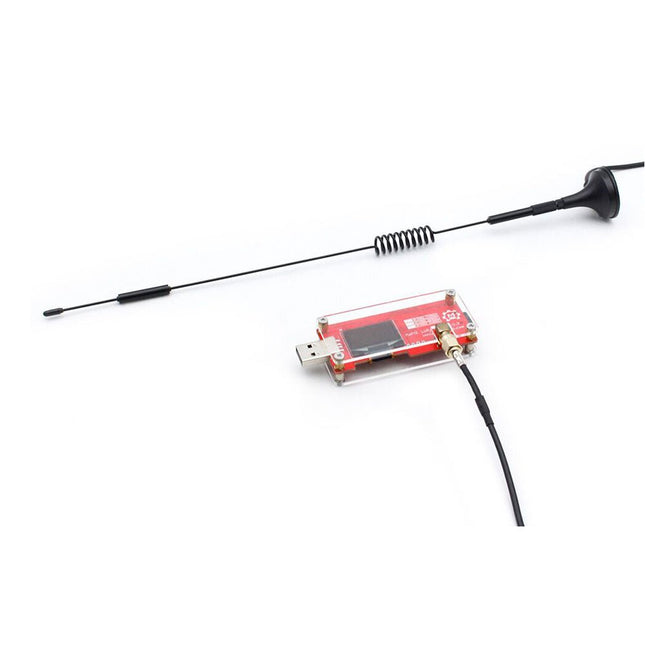
Makerfabs Makerfabs SenseLoRa LoRa Receiver (EU868)
LoRaWAN is beneficial, but sometimes it is unnecessary, difficult, or expensive to implement a LoRaWAN network, especially when considering cloud integration. For example, monitoring soil moisture in your backyard or tracking conditions in your farm's greenhouse may not require a full LoRaWAN setup. This LoRa receiver is designed to work with Makerfabs SenseLora modules. It receives LoRa signals and forwards them to a computer, allowing the data to be displayed, recorded, and analyzed on the computer. Downloads Manual Software
€ 34,95€ 19,95
Members identical
-

ATETOOL T80-D Soldering Tip for Soldering Station AE970D
T80-D (T80-D12) Soldering Tip for Soldering Station AE970D (1.2 mm, chisel)
€ 9,95
Members € 8,96
-
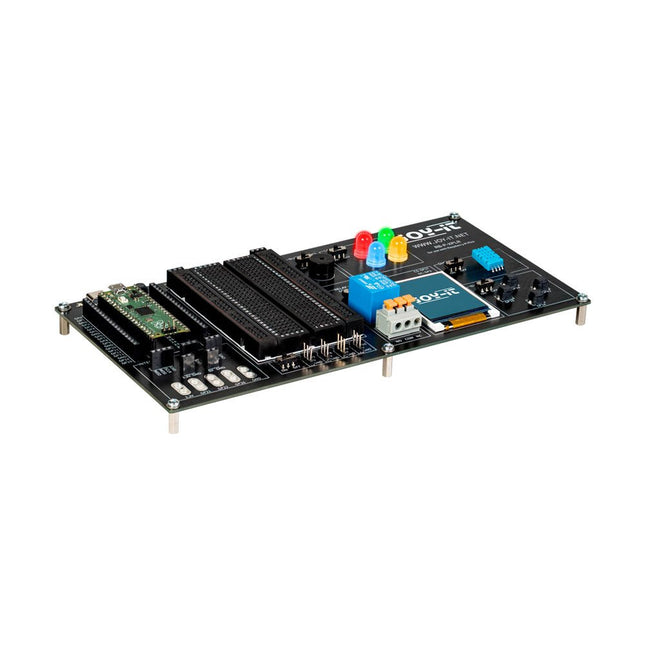
JOY-iT JOY-iT Explorer Board for Raspberry Pi Pico
The Explorer Board is the easy and efficient way to develop your Raspberry Pi Pico projects. Since the most important components are already integrated, you save time and effort on wiring. The Explorer Board has a wide range of interface connectors so you can connect your projects to a variety of modules and devices. With the integrated breadboard, you can quickly build and realize your own projects. Thanks to the possibility to connect or disconnect all modules individually, you can use your pins, which are additionally led separately to the outside, for other projects or experiment on the integrated breadboard at any time. Features Fast and efficient experimenting with the Raspberry Pi Pico Raspberry Pi Pico can be plugged in directly All modules can be switched on and off individually Additional integrated breadboard for own development Specifications Integrated modules: 4 RGB LEDs, buzzer, relay, 1.8“ TFT display, DHT11 temperature sensor, 4 buttons, breadboard Interfaces: 4x servo motor, SPI, I²C, UART, 5x crocodile clip connector Power supply: 5 V USB-C Dimensions: 219 x 110 x 27 mm Downloads Manual Examples and libraries
€ 27,95
Members € 25,16
-
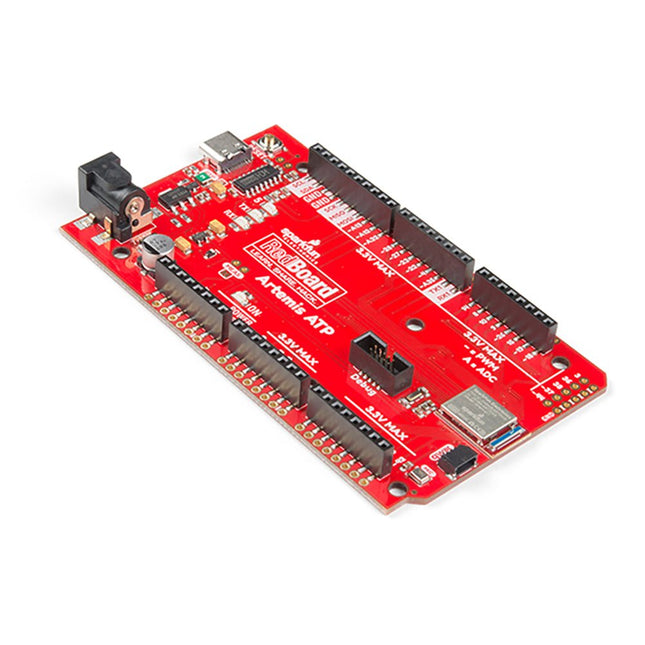
SparkFun SparkFun RedBoard Artemis ATP
What's with the silkscreen labels? They're all over the place. We decided to label the pins as they are assigned on the Apollo3 IC itself. This makes finding the pin with the function you desire a lot easier. Have a look at the full pin map from the Apollo3 datasheet. If you really need to test out the 4-bit SPI functionality of the Artemis, you're going to need to access pins 4, 22, 23, and 26. Need to try out the differential ADC port 1? Pins 14 and 15. The RedBoard Artemis ATP will allow you to flex the impressive capabilities of the Artemis module. The RedBoard Artemis ATP has the improved power conditioning and USB to serial that we've refined over the years on our RedBoard line of products. A modern USB-C connector makes programming easy. A Qwiic connector makes I²C easy. The ATP is fully compatible with SparkFun's Arduino core and can be programmed easily under the Arduino IDE. We've exposed the JTAG connector for more advanced users who prefer to use the power and speed of professional tools. If you need a lot of a GPIO with a simple program, ready to go to the market module, the ATP is the fix you need. We've added a digital MEMS microphone for folks wanting to experiment with always-on voice commands with TensorFlow and machine learning. We've even added a convenient jumper to measure current consumption for low power testing. With 1 MB flash and 384k RAM, you'll have plenty of room for your sketches. The Artemis module runs at 48 MHz with a 96 MHz turbo mode available and with Bluetooth to boot! Features Arduino Mega Footprint 1M Flash / 384k RAM 48MHz / 96MHz turbo available 6uA/MHz (operates less than 5mW at full operation) 48 GPIO - all interrupt capable 31 PWM channels Built-in BLE radio 10 ADC channels with 14-bit precision with up to 2.67 million samples per second effective continuous, multi-slot sampling rate 2 channel differential ADC 2 UARTs 6 I²C buses 6 SPI buses 2/4/8-bit SPI bus PDM interface I²S Interface Secure 'Smart Card' interface Qwiic Connector
€ 30,95€ 19,95
Members identical























